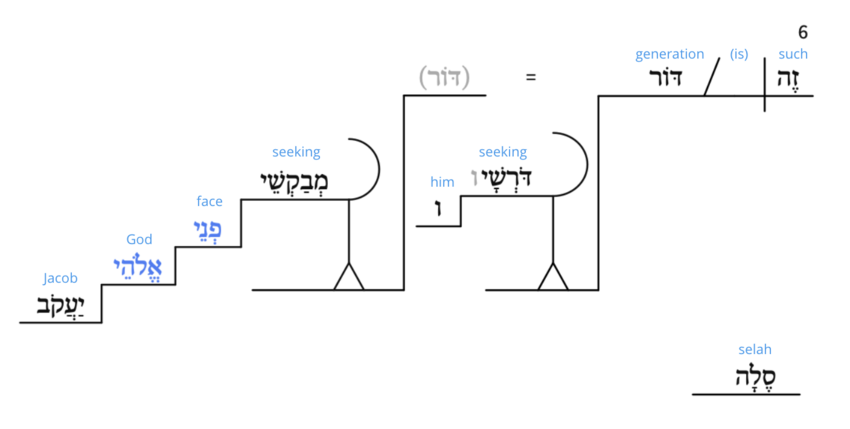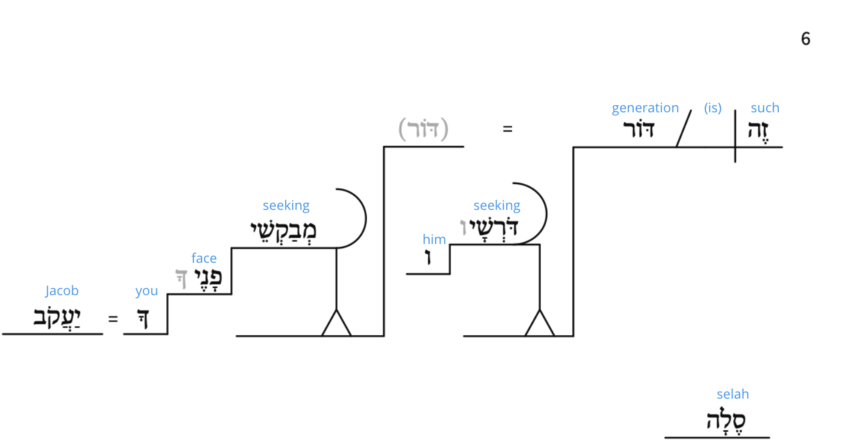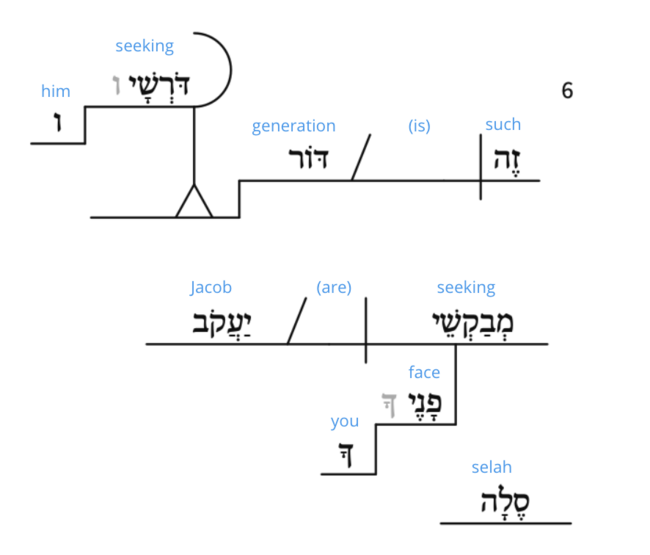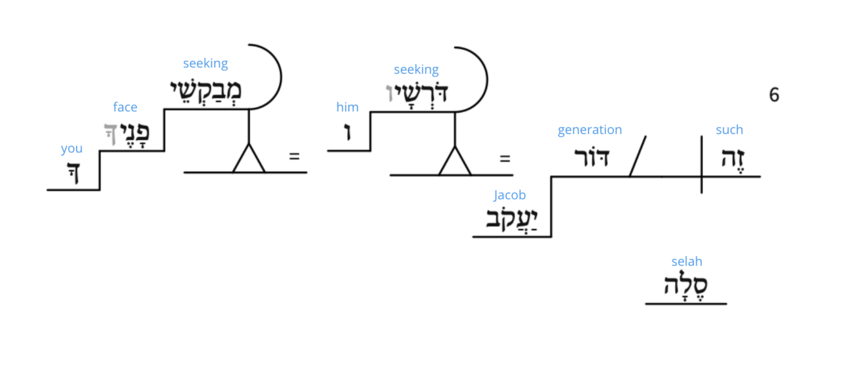The Text, Grammar, and Meaning of Ps. 24:6
Back to Psalm 24
Introduction
The two lines of Psalm 24:6 read as follows:
- זֶ֭ה דּ֣וֹר דֹּרְשָׁ֑יו
- מְבַקְשֵׁ֨י פָנֶ֖יךָ יַעֲקֹ֣ב סֶֽלָה׃.
There is a textual issue in the second line which affects the grammar and meaning of the entire verse. Consider how the following modern translations differ:
- Such is the generation of those who seek him, who seek your face, God of Jacob (NIV)
- This is the generation of those who seek Him, Who seek Your face - even Jacob (NASB)
- Such is the generation of those who inquire of him, who seek the face of the God of Jacob (CSB)
- Voilà ceux qui cherchent vraiment le Seigneur, ceux qui cherchent le visage de Dieu, voilà le vrai peuple de Jacob (PDV)
- Tels sont ceux qui le cherchent, ceux qui se tournent vers Dieu, ô Jacob (NFC)
- The is the generation of those who diligently seek Him and require Him as their greatest need, Who seek Your face, even [as did] Jacob. (AB)
- Such are the people of Jacob who look for the LORD, who seek your face (EHV)
Some versions reflect the presence of the word "God" in the text, while others do not. Some versions take either the "God of Jacob" or "Jacob" himself as a vocative, while others consider Jacob as a comparative or in apposition. Evidently, the textual and therefore interpretive problem is very early. Since the vast majority of modern translations follow the LXX, the question of its textual probability must be asked before considering the syntactic possibilities.
Text
אלהי original
===
model:
removeTagsFromText: true
shortcodes:
":C:": {unicode: "🄲"}
":G:": {unicode: "🄶"}
":A:": {unicode: "🄰"}
":I:": {unicode: "🄸"}
":L:": {unicode: "🄻"}
":D:": {unicode: "🄳"}
":M:": {unicode: "🄼"}
selection:
excludeDisconnected: false
dot:
graphVizSettings:
rankdir: LR
concentrate: true
ranksep: 0.2
nodesep: 0.2
===
<אלהי original>: The text originally included the word אלהי: either פני אלהי יעקב or פניך אלהי יעקב. #dispreferred
+ <Greek and Syriac versions>: Some of the ancient versions probably read אלהי in their parent text. #dispreferred
+ [LXX & Peshitta]: LXX: τὸ πρόσωπον τοῦ θεοῦ Ιακωβ; Peshitta: ܕܐ̈ܦܝܟ ܐܠܗܗ ܕܝܥܩܘܒ #dispreferred
- <Latin and Aramaic versions>: Some of the ancient versions probably read פניך יעקב in their parent text and not אלהי פני(ך) יעקב.
+ [Jerome & Targum]: Jerome: faciem tuam Iacob; Targum: אַפּוֹי יַעֲקֹב
- <Hebrew mss>: The best extant Hebrew manuscripts read פניך יעקב.
+ [Hebrew evidence]: E.g., Leningrad Codex.
- <Hebrew mss minority>: Some medieval Hebrew manuscripts include אלהי. #dispreferred
+ [Hebrew manuscripts evidence]: Kennicott mss 38, 201. #dispreferred
_ <Longer text>: Scribes were more likely to add a word than delete one.
_ <Easier text>: Scribes were more likely to ‘fix’ the text to make it more understandable than make its meaning more obscure.
אלהי not original
===
model:
removeTagsFromText: true
shortcodes:
":C:": {unicode: "🄲"}
":G:": {unicode: "🄶"}
":A:": {unicode: "🄰"}
":I:": {unicode: "🄸"}
":L:": {unicode: "🄻"}
":D:": {unicode: "🄳"}
":M:": {unicode: "🄼"}
selection:
excludeDisconnected: false
dot:
graphVizSettings:
concentrate: true
ranksep: 0.2
nodesep: 0.2
===
<אלהי not original>: The text did not originally include the word אלהי. It read only פניך יעקב.
+ <Ancient versions>: Some of the ancient versions probably read פניך יעקב in their parent text and not אלהי פני(ך) יעקב.
+ [Ancient versions]: Jerome: faciem tuam Iacob; Targum: אַפּוֹי יַעֲקֹב
+ <Hebrew mss>: The best extant Hebrew manuscripts read פניך יעקב.
+ [Hebrew manuscripts]: E.g., Leningrad Codex.
- <Ancient versions>: Some of the ancient versions probably read אלהי in their parent text. #dispreferred
+ [Ancient versions]: LXX: τὸ πρόσωπον τοῦ θεοῦ Ιακωβ; Peshitta: ܕܐ̈ܦܝܟ ܐܠܗܗ ܕܝܥܩܘܒ #dispreferred
+ <Shorter and more difficult>: The reading פניך יעקב (without the word ‘God’) is the shorter and more difficult reading and is therefore to be preferred.
+ <Lectio brevior potior>: Scribes were more likely to add a word than delete one.
+ <Lectio difficilior praeferenda>: Scribes were more likely to ‘fix’ the text to make it more understandable than make its meaning more obscure.
Syntax
If Greek τοῦ θεοῦ and Syriac ܐܠܗܗ ܕ are most likely not original, there seem to be five possible syntactic configurations.
Jacob as vocative
===
model:
removeTagsFromText: true
shortcodes:
":C:": {unicode: "🄲"}
":G:": {unicode: "🄶"}
":A:": {unicode: "🄰"}
":I:": {unicode: "🄸"}
":L:": {unicode: "🄻"}
":D:": {unicode: "🄳"}
":M:": {unicode: "🄼"}
selection:
excludeDisconnected: false
dot:
graphVizSettings:
rankdir: LR
concentrate: true
ranksep: 0.2
nodesep: 0.2
===
<Jacob as vocative>: In the absence of אלהי, the phrase פניך יעקב most naturally reads "your face, Jacob". #dispreferred
+ <Pronominal suffix + nominal constituent>: A nominal constituent immediately following a second person pronominal suffix is most naturally read as direct address. #dispreferred
+ [Ancient versions]: Jerome: faciem tuam Iacob; MT: פניך יעקב. #dispreferred
+ [Unambiguous instances throughout the Pss]: ט֥וֹב נְֽסָה־עָ֭לֵינוּ א֨וֹר פָּנֶ֬יךָ יְהוָֽה׃ (Ps. 4:7), לְךָ֤ ׀ אָמַ֣ר לִ֭בִּי בַּקְּשׁ֣וּ פָנָ֑י אֶת־פָּנֶ֖יךָ יְהוָ֣ה אֲבַקֵּֽשׁ׃ (Ps. 27:8). #dispreferred
- <Identity of Addressee>: In both of these cases, the addressee is YHWH.
+ <Jacob as covenant people>: "Jacob" sometimes refers to the people of Israel, so "Seeking Jacob's face" means seeking to join and become part of the covenant people (cf. Isa. 2; Ibn Ezra :C:; Tromp 1982 :A:). #dispreferred
+ [Jer. 30:10]: וְאַתָּ֡ה אַל־תִּירָא֩ עַבְדִּ֨י יַעֲקֹ֤ב נְאֻם־יְהֹוָה֙ וְאַל־תֵּחַ֣ת יִשְׂרָאֵ֔ל כִּ֠י הִנְנִ֤י מוֹשִֽׁיעֲךָ֙ מֵֽרָח֔וֹק וְאֶֽת־זַרְעֲךָ֖ מֵאֶ֣רֶץ שִׁבְיָ֑ם וְשָׁ֧ב יַעֲקֹ֛ב וְשָׁקַ֥ט וְשַׁאֲנַ֖ן וְאֵ֥ין מַחֲרִֽיד׃. #dispreferred
- <Discourse context>: Psalm 24 is all about seeking and enjoying YHWH's presence.
+ [vv.1-2]: YHWH is Creator and therefore Owner of all (לַֽ֭יהוָה הָאָ֣רֶץ וּמְלוֹאָ֑הּ תֵּ֝בֵ֗ל וְיֹ֣שְׁבֵי בָֽהּ׃ כִּי־ה֖וּא עַל־יַמִּ֣ים יְסָדָ֑הּ וְעַל־נְ֝הָר֗וֹת יְכוֹנְנֶֽהָ׃)
+ [vv. 3-5]: The pure, honest and those of integrity will enter into his presence (מִֽי־יַעֲלֶ֥ה בְהַר־יְהוָ֑ה וּמִי־יָ֝קוּם בִּמְק֥וֹם קָדְשֽׁוֹ׃ נְקִ֥י כַפַּ֗יִם וּֽבַר־לֵ֫בָ֥ב אֲשֶׁ֤ר ׀ לֹא־נָשָׂ֣א לַשָּׁ֣וְא נַפְשִׁ֑י וְלֹ֖א נִשְׁבַּ֣ע לְמִרְמָֽה׃ יִשָּׂ֣א בְ֭רָכָה מֵאֵ֣ת יְהוָ֑ה וּ֝צְדָקָ֗ה מֵאֱלֹהֵ֥י יִשְׁעֽוֹ׃)
+ [vv. 7-10]: YHWH's glorious entry into his people's presence (שְׂא֤וּ שְׁעָרִ֨ים ׀ רָֽאשֵׁיכֶ֗ם וְֽ֭הִנָּשְׂאוּ פִּתְחֵ֣י עוֹלָ֑ם וְ֝יָב֗וֹא מֶ֣לֶךְ הַכָּבֽוֹד׃)
Verbless Clause
===
model:
removeTagsFromText: true
shortcodes:
":C:": {unicode: "🄲"}
":G:": {unicode: "🄶"}
":A:": {unicode: "🄰"}
":I:": {unicode: "🄸"}
":L:": {unicode: "🄻"}
":D:": {unicode: "🄳"}
":M:": {unicode: "🄼"}
selection:
excludeDisconnected: false
dot:
graphVizSettings:
concentrate: true
ranksep: 0.2
nodesep: 0.2
===
<Verbless Clause>: In the absence of אלהי, the line מְבַקְשֵׁ֨י פָנֶ֖יךָ יַעֲקֹ֣ב most naturally reads "those who seek your face are Jacob" (ISV; Hengstenberg 1863-4: 420-421 :C:; Delitzsch 1883: 408 :C:; Briggs 1906-7: 213 :C:). #dispreferred
+ <Possible syntactic parallel with the first line>: A similar structure in the first line makes a verbless clause reading of the second line more likely. #dispreferred
+ <Possible verbless clause in the first line>: If the relationship between דּ֣וֹר and דֹּרְשָׁ֑יו is one of construct, the זֶה demonstrative would head a verbless clause #dispreferred
- <Semantico-syntactic interface>: We expect the antecedent of זֶ֭ה and that of יַעֲקֹ֣ב to be co-referential. This does not seem to be the case.
+ <Interdependency>: BH poetic couplets prototypically express semantic and syntactic interdependency across the two lines.
- <The other two clausal arguments>: If the verse is read as two verbless clauses, the semantic similarity of מְבַקְשֵׁ֨י פָנֶ֖יךָ and דּ֣וֹר דֹּרְשָׁ֑יו is nonetheless evident. #dispreferred
Jacob in Apposition
Consider the NASB: “This is the generation of those who seek Him, who seek Your face - even Jacob. Selah” (the even is italicised to show that it is not original).
Despite the appositional relationship between דּ֣וֹר דֹּרְשָׁ֑יו and מְבַקְשֵׁ֨י פָנֶ֖יךָ, treating "Jacob" as in apposition to the seekers would undergo the same argumentation for and against as the preceding argument map.
Jacob as Comparative
===
model:
removeTagsFromText: true
shortcodes:
":C:": {unicode: "🄲"}
":G:": {unicode: "🄶"}
":A:": {unicode: "🄰"}
":I:": {unicode: "🄸"}
":L:": {unicode: "🄻"}
":D:": {unicode: "🄳"}
":M:": {unicode: "🄼"}
selection:
excludeDisconnected: false
dot:
graphVizSettings:
concentrate: true
ranksep: 0.2
nodesep: 0.2
===
<Jacob as comparative>: In the absence of אלהי, the line מְבַקְשֵׁ֨י פָנֶ֖יךָ יַעֲקֹ֣ב most naturally reads "those who seek your face like Jacob" (e.g., LBLA). #dispreferred
- <Syntactic Ambiguity>: It would remain unclear whether the elided comparative communicates "those who seek your face like Jacob (sought your face)" or "those who seek your face like (they seek Jacob)".
- <Syntactic Probability>: Without an explicit preposition of comparison, like כְּ– or כְּמוֹ, the comparison being left implicit opens to the door to simpler syntactic solutions.
<_ <Haplography>: The original text may have included an explicit preposition of comparison (כ). It is plausible that יעקב was once כיעקב, and that, because the previous word פניך ends in כ, the כ at the beginning of כיעקב was omitted by haplography. #dispreferred
- [Evidence]: There is no textual evidence either in the ancient versions or Hebrew manuscripts to support such a reconstruction.
Vertical Grammar
===
model:
removeTagsFromText: true
shortcodes:
":C:": {unicode: "🄲"}
":G:": {unicode: "🄶"}
":A:": {unicode: "🄰"}
":I:": {unicode: "🄸"}
":L:": {unicode: "🄻"}
":D:": {unicode: "🄳"}
":M:": {unicode: "🄼"}
selection:
excludeDisconnected: false
dot:
graphVizSettings:
concentrate: true
ranksep: 0.2
nodesep: 0.2
===
<Jacob as genitive of דּוֹר>: In the absence of אלהי, the lines זֶ֭ה דּ֣וֹר דֹּרְשָׁ֑יו מְבַקְשֵׁ֨י פָנֶ֖יךָ יַעֲקֹ֣ב most naturally read "this is the generation of - those who seek him, who seek your face - Jacob" (CJB; EHV; NVSR; Tsumura 2023: 22 :M:).
- <Prosody>: דרשׁו stands in close prosodic proximity to the head noun דור, and so דור is probably in construct with דרשׁו and not with יעקב. #dispreferred
+ <Ancient interpretation>: All of the ancient versions understood דור דרשו as a construct phrase. #dispreferred
+ [Ancient versions]: LXX: ἡ γενεὰ ζητούντων αὐτόν; Jerome: haec generatio quarentium eum; Targum: דָרָא דְתָבְעִין לֵיהּ; Peshitta: ܕܪܐ ܕܒܥܐ. #dispreferred
+ [Masoretic accents]: The constituents דור and דרשׁו are prosodically combined with a conjunctive accent (munakh). #dispreferred
+ <The ax // x'b poetic structure>: ax - x'b is a common poetic structure. The 'X' would be broken into two small x's, namely דֹּרְשָׁ֑יו and מְבַקְשֵׁ֨י פָנֶ֖יךָ, both participles with object constituents. A and B, however, don't have to share such semantico-syntactic similarities. (Tsumura 1982 :A:, 1983 :A:, 1986 :A:)
+ [Other Examples]: Hab. 2:1b, 3:6a, 3:13b; Isa. 64:9b, Ps. 2:4 (see Appendix B).
+ <Most likely collocation of דּוֹר>: The construct chain headed by דּוֹר more commonly takes its dependent as either a noun or substantive adjective (cf. Ps. 14:5, 49:20, 112:2), rather than a verbal idea.
- <Word order obfuscated in translation>: The syntax is obscured by the linear order of the two lines. #dispreferred
_ <Vertical Grammar>: As is the nature of Vertical Grammar, constituents in different lines are grammatically dependent on each other, so are not expected to be reflected in the linear order of the line grouping.
Conclusion
Tsumura (2023: 22) proposes following translation:
This is the generation of Jacob,
those who seek him
those who seek your face.
His solution solves the need to insert the word ‘God’ in the text to make sense of seeking Jacob’s face, and provides a more satisfying solution to the syntax of this bicolon than the options of understanding Jacob in apposition or the second line as an independent verbless clause. While either of these three are valid readings of the text and could be considered in translation, Tsumura’s Vertical Grammar seems preferable. Under this understanding of the text, those names in vv.4-5 are identified as the generation of Jacob, which is then expanded by two participial phrases which also characterise them: they seek YHWH face (x) and seek YHWH's face (x').
Sources
Ancient Translations
- LXX: αὕτη ἡ γενεὰ ζητούντων αὐτόν,
ζητούντων τὸ πρόσωπον τοῦ θεοῦ Ιακωβ.
- Peshitta: ܗܢܘ ܕܪܐ ܕܒܥܐ
ܘܡܣܒܪ܂ ܠܦܪܨܘܦܐ ܕܐ̈ܦܝܟ ܐܠܗܗ ܕܝܥܩܘܒ܂
- Targum: דְנָן דָרָא דְתָבְעִין לֵיהּ
דְבָעִין סְבַר אַפּוֹי יַעֲקֹב לְעָלְמִין:
- Jerome: haec generatio quarentium eum
quaerentium faciem tuam Iacob
Modern Translations
English
- Such is the generation of those who seek him, who seek your face, God of Jacob (NIV; NLT, ESV, CSB, CEV, RSV)
- This is the generation of those who seek him, who seek your face - even Jacob (NASB; AB, NET, JPS)
- Such is the character of those who seek him, of Ya׳akov, who seeks your face (CJB)
- Such are the people of Jacob who look for the Lord, who seek your face (EHV)
German
- Das ist das Geschlecht, das nach ihm fragt, das da sucht dein Antlitz, Gott Jakobs (Luther 2017)
- Das gilt den Menschen, die sich nach dir richten und im Gebet deine Nähe suche, du Gott Jakobs (HFA)
- Das ist sad Geschlecht derer, die nach ihm trachten, die dein Angesicht suchen: Jakob (ELB) / Sie sind die rechten Nachkommen Jakobs (NGÜ, GNB)
- Das ist das Geschlecht derer, die nach ihm fragen, die dein Angesicht suchen, Jakob (ZÜR, EÜ)
French
- O Eternel, tel est le peuple qui se tourne vers toi et qui s'attache à toi, Dieu de Jacob (BDS)
- Telle est la race de ceux qui le cherchent, qui recherchent ta face: c'est Jacob! (TOB, NBS, PDV)
- Tels son ceux qui le cherchent, ceux qui se tournent vers Dieu, ô Jacob (NFC)
- Telle est la génération de ceux qui le recherchent, de ceux qui cherchent ta face, de Jacob! (NVSR)
Spanish
- Tal es la generación de quienes lo buscan, de los que buscan el rostro del Dios de Jacob (BTX 4ª)
- Tal es la generación de los que le buscan, dude los que buscan tu rostro, oh Dios de Jacob (RVA-2015)
- Tal es la generación de los que le buscan, de los que buscan tu rostro, como Jacob (LBLA)
Commentators
- Das is das Geschlecht derer, die nach ihm fragen, Die sad Antlitz des Gottes Jakobs suchen (Duhm 1899: 76)
- This is the generation of those who seek him, of those seeking the face of the God of Jacob (deClaisse-Walford, N., Jacobson, R. and Tanner, B. L. (2014) The Book of Psalms. [edition unavailable]. Wm. B. Eerdmans Publishing Co. Available at: https://www.perlego.com/book/2015638/the-book-of-psalms-pdf (Accessed: 1 May 2023).)
---
- Dies ist das Geschlecht das nach ihm fragt, die dein Antlitz suchen, Gott Jakobs (Hupfield 1868: 104)
- Such are they that worship him, that seek Thy face, [O God of] Jacob (Perowne 1870-1: 245)
- This is the generation of them that seek him, that seek thy face, O God of Jacob (Kirkpatrick 1897:130)
- "In 6b ist nach der Texteslesart יעקב Apposition zu דור דרשו > das Geschlecht derer, die ihn suchen... nämlich Jakob (d.i. das wahre Israel). Aber diese Ausdrucksweise würde sehr hart sein, und zudem erwartet man hinter פניך einen Vokativ. LXX übersetzen τὸ πρόσωπον τοῦ θεοῦ Ἰακώβ, Syr. faciem tuam, deus Jacob. Beides ist vermutlich eine Konjektur, die aber das Richtige getroffen haben wird, insofern vor יעקב ein אֱלֹהֵי eingeschoben werden muss. So lesen zwei hebr. Codices. (Baethgen 1904: 69)
- Solch Volk begehrt deine, und sucht auf dein Antlitz, o du Gott Jakobs (Kittel 1922: 93)
- Such is the generation of those who seek him, who seek your face, O God of Jacob (Wilson, G. (2014) Psalms Volume 1. [edition unavailable]. Zondervan Academic. Available at: https://www.perlego.com/book/560337/psalms-volume-1-pdf (Accessed: 1 May 2023).)
- This is the generation of those who consult him, of those who seek your face, O God of Jacob (Craigie, P. and Tate, M. (2018) Psalms 1-50, Volume 19. [edition unavailable]. Zondervan Academic. Available at: https://www.perlego.com/book/727793/psalms-150-volume-19-pdf (Accessed: 1 May 2023).)
- Such is the generation of those who seek him, who seek your face, O God of Jacob (VanGemeren, W. (2017) Psalms. [edition unavailable]. Zondervan Academic. Available at: https://www.perlego.com/book/560264/psalms-pdf (Accessed: 1 May 2023).)
---
- יעקב סלה - פירוש הם זרע יעקב ואין צורך לפירוש, אחר שאמר תחסר מלת אלהי יעקב. (Ibn Ezra; https://www.sefaria.org/Ibn_Ezra_on_Psalms.24.6?lang=bi)
---
- This is the generation which reverences Him: they who seek thy face, are Jacob (Hengstenberg 1863-4: 420)
- This is the generation seeking him; the seekers of they face (are) Jacob (Delitzsch 1883: 408)
- This is a generation which resorts to Him; Those who seek His face are Jacob (Briggs 1906-7: 213)
---
- מבקשי פניך יעקב כנגד האל מדבר המשורר: הם הם שיבקשו פניך בבית המקדש, יעקב והם ישראל; (Qimḥi; https://www.sefaria.org/Radak_on_Psalms.24.6?lang=bi)
- "He adds the word Jacob, for the confirmation of the same doctrine putting it for those who were descended from Jacob" (Calvin 1571; https://ccel.org/ccel/calvin/calcom08/calcom08.xxx.ii.html)
- Also das Geschlecht derer, die ihm zustreben, die dein Wohlwollen suchen, Jacob (Ehrlich 1905: 51)
- Such is the company of those who have recourse to him, those who seek your face - Jacob... "Jacob" is nominative and stands in parallelism with "company," as "those who seek your face" stands in parallelism with "those who have recourse to him." “Jacob” makes explicit that the “company” (dôr) is more than a collection of unrelated people the word often means a “generation” and in the context of Israel thus suggests a group of related people. This company comprises the descendants of Jacob alive at a particular moment. They are the people who have recourse to or *seek help from Yhwh. (J. Goldingay (2006) Psalms : Volume 1 (Baker Commentary on the Old Testament Wisdom and Psalms). [edition unavailable]. Baker Publishing Group. Available at: https://www.perlego.com/book/2039500/psalms-volume-1-baker-commentary-on-the-old-testament-wisdom-and-psalms-psalms-141-pdf (Accessed: 1 May 2023).)
References
Appendix A: Other instances of לְבַקֵּשׁ פַּנִים
וַיְהִ֣י רָעָב֩ בִּימֵ֨י דָוִ֜ד שָׁלֹ֣שׁ שָׁנִ֗ים שָׁנָה֙ אַחֲרֵ֣י שָׁנָ֔ה וַיְבַקֵּ֥שׁ דָּוִ֖ד אֶת־פְּנֵ֣י יְהוָ֑ה ס וַיֹּ֣אמֶר יְהוָ֗ה אֶל־שָׁאוּל֙ וְאֶל־בֵּ֣ית הַדָּמִ֔ים עַל־אֲשֶׁר־הֵמִ֖ית אֶת־הַגִּבְעֹנִֽים׃ (2 Sam. 21:1)
אֵלֵ֤ךְ אָשׁ֙וּבָה֙ אֶל־מְקוֹמִ֔י עַ֥ד אֲשֶֽׁר־יֶאְשְׁמ֖וּ וּבִקְשׁ֣וּ פָנָ֑י בַּצַּ֥ר לָהֶ֖ם יְשַׁחֲרֻֽנְנִי׃ (Hos. 5:15)
לְךָ֤׀ אָמַ֣ר לִ֭בִּי בַּקְּשׁ֣וּ פָנָ֑י אֶת־פָּנֶ֖יךָ יְהוָ֣ה אֲבַקֵּֽשׁ׃ (Ps. 27:8)
דִּרְשׁ֣וּ יְהוָ֣ה וְעֻזּ֑וֹ בַּקְּשׁ֖וּ פָנָ֣יו תָּמִֽיד׃ (Ps. 105:4 = 1 Chr. 16:11)
וְיִכָּנְע֨וּ עַמִּ֜י אֲשֶׁ֧ר נִֽקְרָא־שְׁמִ֣י עֲלֵיהֶ֗ם וְיִֽתְפַּֽלְלוּ֙ וִֽיבַקְשׁ֣וּ פָנַ֔י וְיָשֻׁ֖בוּ מִדַּרְכֵיהֶ֣ם הָרָעִ֑ים וַאֲנִי֙ אֶשְׁמַ֣ע מִן־הַשָּׁמַ֔יִם וְאֶסְלַח֙ לְחַטָּאתָ֔ם וְאֶרְפָּ֖א אֶת־אַרְצָֽם׃ (2 Chr. 7:14)
---
וְכָ֨ל־הָאָ֔רֶץ מְבַקְשִׁ֖ים אֶת־פְּנֵ֣י שְׁלֹמֹ֑ה לִשְׁמֹ֙עַ֙ אֶת־חָכְמָת֔וֹ אֲשֶׁר־נָתַ֥ן אֱלֹהִ֖ים בְּלִבּֽוֹ׃ (1 Kgs. 10:24 = 2 Chr. 9:23)
רַ֭בִּים מְבַקְשִׁ֣ים פְּנֵי־מוֹשֵׁ֑ל וּ֝מֵיְהוָ֗ה מִשְׁפַּט־אִֽישׁ׃ (Prov. 29:26)
Appendix B: Other instances of a-x // x׳-b and similar structures
לִרְאוֹת֙ מַה־יְדַבֶּר־בִּ֔י
וּמָ֥ה אָשִׁ֖יב עַל־תּוֹכַחְתִּֽי׃ (Hab. 2:1b)
to see (a) what he will say to me (x)
and what I shall respond (y) concerning my complaint (b) (Tsumura 2023: 60)
עָמַ֣ד׀ וַיְמֹ֣דֶד אֶ֗רֶץ
רָאָה֙ וַיַּתֵּ֣ר גּוֹיִ֔ם (Hab. 3:6a)
He stood, and shook the earth;
he looked, and made the nations tremble. (NIV)
When he stood (a) [and] looked (b),
he made the earth shake (x) and the nations tremble (x'). (Tsumura 2023: 61)
מָחַ֤צְתָּ רֹּאשׁ֙ מִבֵּ֣ית רָשָׁ֔ע
עָר֛וֹת יְס֥וֹד עַד־צַוָּ֖אר (Hab. 3:13b).
You crushed the head of the house of the wicked,
laying bare the foundation to the neck. (ESV)
You crushed the leader of the land of wickedness,
you stripped him from head to foot. (NIV)
You will smash the roof of the villain's house,
Raze it from the foundation to top. (JPS)
You crushed the head (a) to the neck (b),
from the house of the wicked (x) laying the foundation bare (y). (Tsumura 2023: 64)
צִיּוֹן֙ מִדְבָּ֣ר הָיָ֔תָה
יְרוּשָׁלִַ֖ם שְׁמָמָֽה׃ (Isa. 64:9b)
Zion has become a wilderness,
Jerusalem a desolation. (ESV)
A compound sentence would require:
Zion has become a wilderness,
Jerusalem [has become] a desolation.
But in light of the common construct chain מִדְבָּר שְׁמָמָה (cf. Jer. 12:10, Joel 2:3, 4:19) and the co-referentiality of Zion and Jerusalem, it is better understood as a simple sentence:
y a x
צִיּוֹן֙ מִדְבָּ֣ר הָיָ֔תָה
b. x'
יְרוּשָׁלִַ֖ם שְׁמָמָֽה׃
Zion Jerusalem has become a wilderness of desolation. (Tsumura 2023: 65)
יוֹשֵׁ֣ב בַּשָּׁמַ֣יִם יִשְׂחָ֑ק
אֲ֝דֹנָ֗י יִלְעַג־לָֽמוֹ׃ (Ps. 2:4)
Instead of: He who sits in the heavens laughs; the Lord scoffs at them.
Taking "laugh" and "scoff" as a verbal hendiadys with one object (לָמוֹ) would result the following understanding of this bicolon:
He who sits in the heavens, that is, the Lord, laughs and scoffs at them. (Tsumura 2023: 66).
References
24:6 Approved




